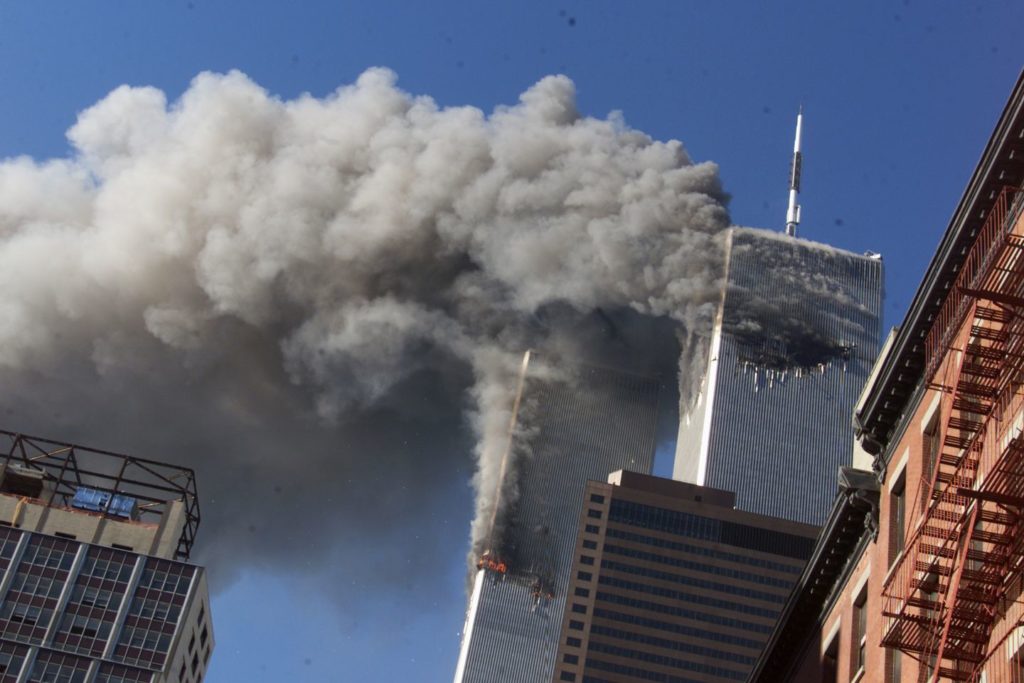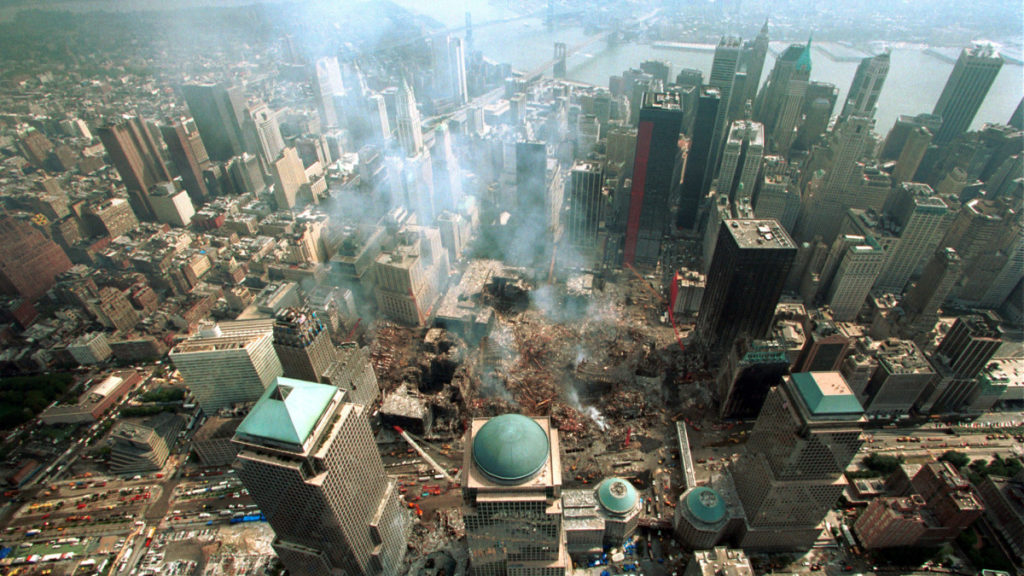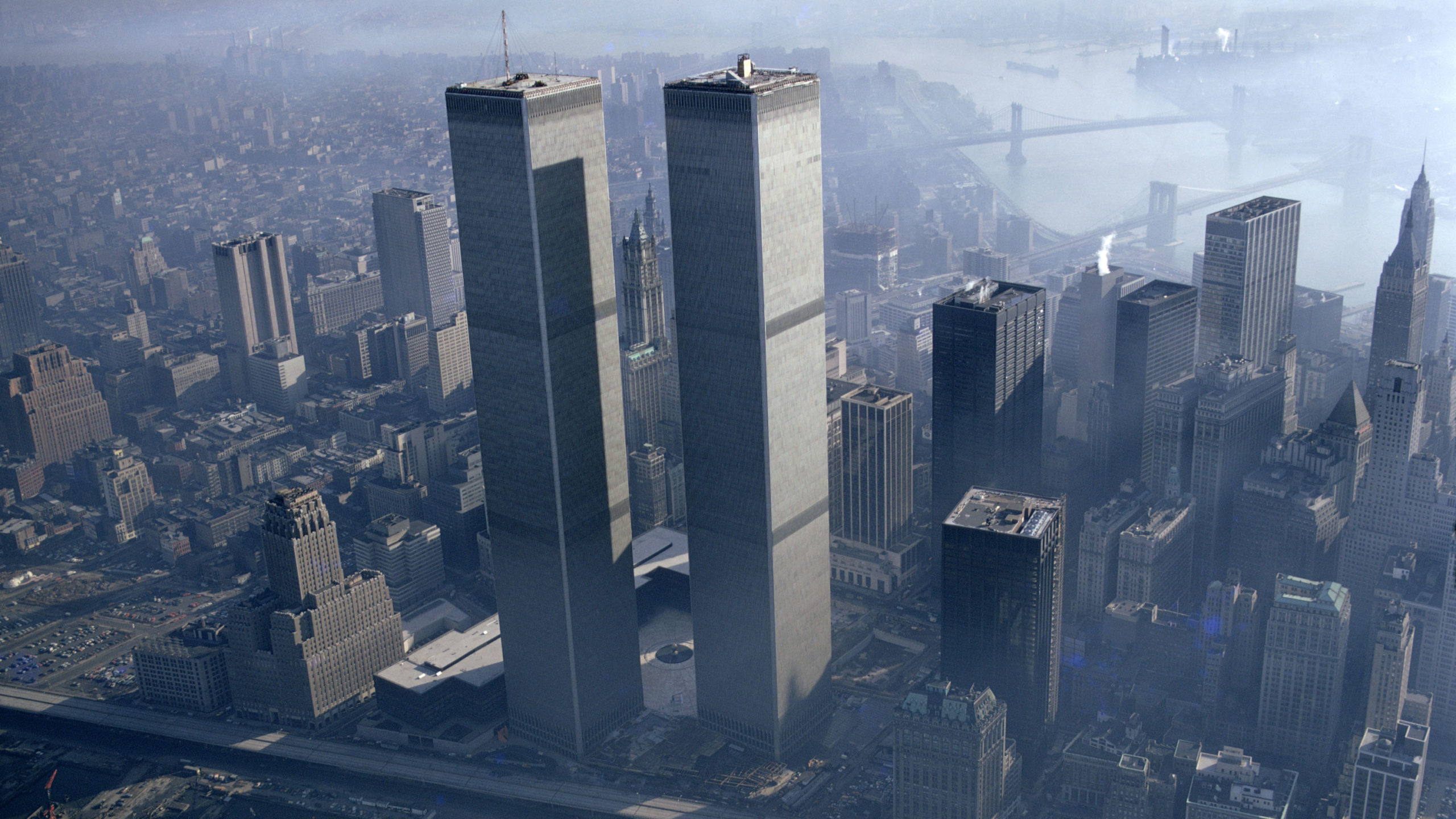Sept. 11, 2001: “American 11 heavy, Boston Center. Your transponder appears to be inoperative. Please recycle. . . . American 11 heavy, how do you read Boston Center? Over.
“Watch supervisor, I have a possible hijack of American 11 heavy. Recommend notifying Norad.”
At 8:40 a.m. EDT, Tech. Sgt. Jeremy W. Powell of North American Aerospace Defense Command’s (Norad) Northeast Air Defense Sector (NEADS) in Rome, N.Y., took the first call from Boston Center. He notified NEADS commander Col. Robert K. Marr, Jr., of a possible hijacked airliner, American Airlines Flight 11.
“Part of the exercise?” the colonel wondered. No; this is a real-world event, he was told. Several days into a semiannual exercise known as Vigilant Guardian, NEADS was fully staffed, its key officers and enlisted supervisors already manning the operations center “battle cab.”
In retrospect, the exercise would prove to be a serendipitous enabler of a rapid military response to terrorist attacks on Sept. 11. Senior officers involved in Vigilant Guardian were manning Norad command centers throughout the U.S. and Canada, available to make immediate decisions.
Marr ordered two F-15 fighters sitting alert at Otis Air National Guard (ANG) Base, Mass., to “battle stations.” “The fighters were cocked and loaded, and even had extra gas on board,” he recalled.
Marr called Maj. Gen. Larry Arnold, commander of the Continental U.S. Norad Region (Conar), at Tyndall AFB, Fla., told him about the suspected hijacked aircraft and suggested interceptors be scrambled. Arnold, who also heads the 1st Air Force for Air Combat Command, was in his Air Operations Center preparing for another day of the exercise.
“I told him to scramble; we’ll get clearances later,” Arnold said. His instincts to act first and get permission later were typical of U.S. and Canadian commanders that day. On Sept. 11, the normal scramble-approval procedure was for an FAA official to contact the National Military Command Center (NMCC) and request Pentagon air support. Someone in the NMCC would call Norad’s command center and ask about availability of aircraft, then seek approval from the Defense Secretary–Donald H. Rumsfeld–to launch fighters.
Lt. Col. Timothy (Duff) Duffy, a 102 Fighter Wing (FW) F-15 pilot at Otis ANGB, had already heard about the suspected hijacking, thanks to a phone call from the FAA’s Boston Approach Control. He had the call transferred to the unit’s command post, grabbed Maj. Daniel (Nasty)Nash, his wingman, and started suiting up. Another officer told Duffy, “This looks like the real thing.”
“Halfway to the jets, we got ‘battle stations,’ and I briefed Nasty on the information I had about the American Airlines flight,” Duffy said. “About 4-5 min. later, we got the scramble order and took off.”
Also an airline pilot, Duffy had a bad feeling about the suspected hijacking; something didn’t feel right. Consequently, he jammed the F-15’s throttles into afterburner and the two-ship formation devoured the 153 mi. to New York City at supersonic speeds. “It just seemed wrong. I just wanted to get there. I was in full-blower all the way,” he said.

Unknown to Duffy, Nash and every commander being notified at the time, American Flight 11 had crashed into the north tower of the World Trade Center (WTC) about the time both F-15s were taking off. America’s terrorist nightmare had begun.
Almost simultaneous with Marr’s call to Arnold at Conar, the same hijack notification was being passed by phone to a Norad command center deep inside Cheyenne Mountain near Colorado Springs, and the joint FAA/ Defense Dept. Air Traffic Services Cell (ATSC) colocated with the FAA’s ATC System Command Center in Herndon, Va. (AW&ST Dec. 17, 2001, p. 96).
“NEADS instantly ordered the scramble, then called me to get Cinc [Norad commander-in-chief] approval for it,” said Capt. Michael H. Jellinek, a Canadian Forces (Navy) officer serving as Norad command director that morning. He’s also director of plans, requirements and readiness at Norad’s Cheyenne Mountain Air Force Station. Fortunately, Maj. Gen. Eric A. Findley, another Canadian and Norad’s director of operations, was already in the mountain for the Vigilant Guardian exercise. He quickly approved the fighters’ launch.
Back at the NEADS Operations Center, identification technicians were sorting thousands of green dots on their radar scopes, looking for American Flight 11. Since terrorists had turned off the Boeing 767’s transponder, FAA controllers could only tell NEADS technicians where the flight had last been seen. The NEADS radar screens showed “primary” or “skin-paint” returns, the raw radar pulses reflected from an aircraft’s surface.
Ironically, FAA officials only a few months earlier had tried to dispense with “primary” radars altogether, opting to rely solely on transponder returns as a way to save money. Norad had emphatically rejected the proposal. Still, on Sept. 11, Norad’s radars were spread around the periphery of the U.S., looking outward for potential invaders. Inside U.S. borders, very few radars were feeding NEADS scopes.
In essence, technicians were half-blind, trying to separate hijacked airliners from thousands of skin-paint returns. At the time, more than 4,000 aircraft were airborne over the nation, most in the northeast sector, which monitors half a million square miles of airspace.
“We were trying to determine which [radar return] was him. But we couldn’t get what we needed just from our scopes,” said MSgt. Maureen Dooley, a noncommissioned officer in charge (NCOIC) of NEADS’ identification technicians. She and other troops were constantly on the phone with the FAA, airlines and others, looking for clues. “If we could get good last-known-positions and tail numbers, that would help the fighters pick out the right aircraft.”
“The biggest task was maintaining track continuity,” echoed Tech. Sgt. Jeffrey Lamarche, NCOIC of the air surveillance section. Later, his team thought they had spotted a fifth hijacked aircraft. “This fifth guy made an abrupt turn toward a major city–but it was OK. He was told to land there. It sure had our hearts going and adrenaline pumping. We didn’t know what he was doing.”
Marr capsulized the tense moments: “The NEADS battle managers get the last known location, estimate [Flight AA11’s] speed and find a green dot that’s not identified. Almost as soon as it’s discovered, it disappears. It’s 8:46 a.m. A shocked airman rushes from the computer maintenance room saying, ‘CNN is reporting that the World Trade Center has been hit by an airliner.’ There are no other missing aircraft. As we watch the TV, another airliner shows up on the screen, aimed for the second tower [9:02 a.m.]. The shocking reality becomes apparent. This is no longer ‘an accident.’ New York City is under attack.”
Flying supersonically, the F-15s were still 8 min. from Manhattan when United Airlines Flight 175 smashed into the WTC’s south tower. “Huntress,” the NEADS weapons control center, had told Duffy his hijacked target was over John F. Kennedy International Airport. He hadn’t heard about the United aircraft yet.
“The second time I asked for bogey dope [location of AA11], Huntress told me the second aircraft had just hit the WTC. I was shocked . . . and I looked up to see the towers burning,” Duffy said. He asked for clarification of their mission, but was met with considerable confusion.

In Norad’s command center, “a bunch of things started happening at once,” Jellinek said. “We initiated an Air Threat Conference [call]. We were getting information about other possible hijackings.” Telephone links were established with the NMCC, Canada’s equivalent command center, Strategic Command, theater Cincs and federal emergency-response agencies. At one time or another, President Bush, Vice President Dick Cheney, Rumsfeld and key military officers were heard on the open line.
Confusion was rampant, but officers and enlisted troops immediately reverted to their professional roles, trying to sort rumor from fact. Findley and his senior staff in the Norad Battle Management Center told each air defense sector to “generate, generate, generate” sorties–get as many fighters in the air as possible.
AT THE TIME, NORAD had 20 fighters on armed alert throughout the North American continent. Only 14 were in the continental U.S. at seven bases; the rest were in Alaska and Canada. Within 18 hr., 300 fighters would be on alert at 26 locations.
Calls from fighter units also started pouring into Norad and sector operations centers, asking, “What can we do to help?” At Syracuse, N.Y., an ANG commander told Marr, “Give me 10 min. and I can give you hot guns. Give me 30 min. and I’ll have heat-seeker [missiles]. Give me an hour and I can give you slammers [Amraams].”
Marr replied, “I want it all.” NEADS controllers put F-16s at Langley AFB, Va., on battle-stations alert at 9:09 a.m., prepared to back up the F-15s over New York. But the FAA command center then reported 11 aircraft either not in communication with FAA facilities, or flying unexpected routes. At 9:24, the Langley-based alert F-16s were scrambled and airborne in 6 min., headed for Washington.
By 9:26 a.m., the FAA command center stopped all departures nationwide. At 9:41, American Flight 77 crashed into the Pentagon, elevating tension levels even further. NEADS’ Sr. Airman Stacia Rountree, an identification technician, said, “We had three aircraft down and the possibility of others hijacked. We had to think outside the box,” making up procedures on the fly. Before the day ended, 21 aircraft across the U.S. had been handled as “tracks of interest.”
“We didn’t know how many more there were. . . . Are there five? Six? The only way we could tell was to implement Scatana–sanitize the airspace. Get everybody down,” said Lt. Col. William E. Glover, Jr., chief of Norad’s air defense operations.
Gen. Ralph E. Eberhart, Norad commander-in-chief, was in the Cheyenne Mountain battle center by then. He and his staff suggested, via an open command link, implementing a limited version of Scatana–a federal plan designed to take emergency control of all domestic air traffic and navigation aids. Transportation Secretary Norman Y. Mineta immediately concurred and gave the order to get all aircraft on the ground as soon as possible. That action probably saved many lives, but without unnecessary, paralyzing restrictions of a full Scatana order.
Mineta’s decision–and the military recommendation that triggered it–may have been prompted by a few airline pilots reporting terrorists on the radio, talking about other hijacked aircraft. American Flight 77 had hit the Pentagon, and United Flight 93 was being tracked, heading for Chicago or Cleveland, then Washington, prompting the F-16s’ scramble.
“We had all of our armed fighters in the air, but needed more,” Marr said. Every unit in the northeastern U.S. was loading F-16s, F-15s and A-10s with any armament available, then being directed to combat air patrols (CAPs) over major cities. Soon, Navy F/A-18s, F-14s and E-2Cs–some from two carriers steaming off the East Coast–were flying CAP and surveillance missions over major cities. Ultimately, Navy P-3s and USAF/ ANG C-130s would be pressed into service, using their normal radars to search for intruders.
At Norad, Glover phoned Arnold, telling him Vice President Cheney had given the authorization to shoot down any threatening aircraft in order to save lives on the ground. “We created a free-fire zone over the nation’s capital,” Arnold said. “Anyone airborne who did not immediately turn away from the center of town, or who did not land, could be shot down.”
When someone–possibly President Bush–ordered the military to a Force Protection Condition Delta wartime posture, Norad commanders ordered massive steel doors be closed, “shutting down Cheyenne Mountain for real,” the first time in its 43-year history, an officer said. The FBI had warned that a flight originating in San Diego might be hijacked and headed for a target in Colorado. Another rumor referred to a Ryder rental truck full of explosives and driven by “Arab-looking men” targeting the mountain.
“It didn’t make sense, but those phone calls were happening,” Glover said. Every rumor was treated as a potential threat.
OVER NEW YORK, Duffy and Nash requested that a Maine-based ANG KC-135 tanker–assigned to support 102 FW training missions that morning–be positioned at 20,000 ft. above Kennedy airport. “Then, we worked on intercepting and visually identifying nearly everything that was in the air for the next five hours,” Duffy said.
“I treated this as a combat hop from the moment I saw the towers burning, and that made it easier to deal with . . . actions we might have to take,” he added.
Duffy estimated the F-15s intercepted and escorted about 100 aircraft, including emergency, military and news helicopters, plus dozens of private pilots who were unaware of the attacks. Some had seen the smoke over New York and decided to investigate. Nash said the F-15s flew “low-and-slow” to intercept helicopters flying at 500 ft.
When the KC-135 exhausted its fuel load and had to depart, a KC-10 arrived to support the F-15s. Another two Eagles from Otis ANGB joined the first two, flying CAP over New York. Duffy and Nash were directly over the north WTC tower when it collapsed. When they finally returned to Otis, they had been on CAP about 5.5 hr.
Above Washington, F-16s flown by crews of the 119th FW from Fargo, N.D.–which had been pulling Norad alert duty at Langley AFB–were prepared to shoot down United 93, if it came toward the capital city. Instead, passengers rushed the terrorists, causing the Boeing 757 to crash in southwestern Pennsylvania.
MAJ. PHILIP J. MCCARTHY, a weapons controller at NEADS, located an AWACS crew in the southeastern U.S. on a training mission and arranged to reposition it in the Northeast. “We wanted D.C. as the primary area for AWACS, but also wanted him to look into New York,” he said. In the confusion of the all-aircraft-grounding, someone told the AWACS to go back to Tinker AFB, Okla., its home base, but McCarthy was able to convince the crew to stay.
At the Herndon ATSC, Col. John Czabaranek and a growing staff of USAF Reserves–many reported, unasked, to help with the crisis–had become a critical communications node, shuttling information among the FAA, Norad, air defense sectors, the White House, Secret Service and other agencies. During the day, ATSC helped organize fighter escorts for Bush’s Air Force One. The President was in Sarasota, Fla., when the attacks occurred, but was quickly taken to Barksdale AFB, La., then to Offutt AFB, Neb.
At one point, the Secret Service wanted to get Bush into Cheyenne Mountain, protected by tons of granite, yet well-connected to his staff. However, advisers convinced him that he should “remain visible to the public,” an officer said.
“We received tasking from the Secret Service . . . to follow the President and protect him,” Conar commander Arnold said in Lockheed Martin’s Code One magazine. “We were not told where Air Force One was going. We were told just to follow the President. We scrambled available airplanes from Tyndall and then from Ellington [AFB] near Houston, Tex. . . . We maintained AWACS overhead the whole route.”
Late in the day, after NEADS confirmed a suspected hijacked airliner from Madrid, Spain, had turned around and was on the ground, Air Force One was cleared to return Bush to Washington. NEADS and the Herndon cell also organized fighter escorts for Attorney General John Ashcroft and other national leaders when deemed necessary.
WHILE ALL MILITARY units responded quickly and professionally on Sept. 11, “citizen soldiers” were typically first on the scene. Air National Guard and Reserve units were called initially, simply because many of them were easier to contact without going through a long, tortuous chain of command. Since then, outmoded procedures have been altered to ensure faster reactions from all units.
“The responsiveness of the Air National Guard [and other] units called into action–and how quickly they all came to the defense of the United States–was phenomenal,” said Col. Clark F. Speicher, NEADS vice commander. “Within a couple of hours, many of these units went from normal training to generating armed combat air patrols over many U.S. cities. There may have been a lot of different [armament] configurations out there, but so what.” Fighters typically carried Aim-9, Aim-7 or Amraam missiles, and 20-mm. ammunition.
